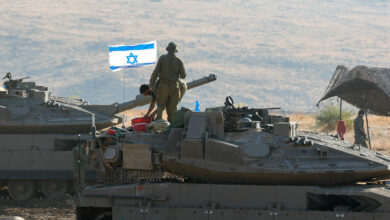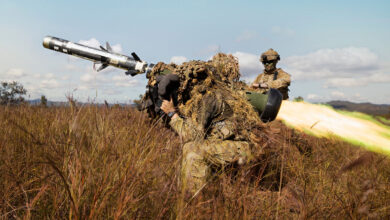US hands over 4 more A-29 Super Tucano aircraft to Lebanon
Four A-29 Super Tucano light attack aircraft were formally handed over to Lebanon by the United States at Hamat air base on June 12, two months ahead of schedule, completing an order of six planes.
The aircraft arrived in the country on May 28.
Speaking at the handover ceremony, the commander of the Lebanese Armed Forces, General Joseph Aoun highlighted the “historic friendship” between the U.S and Lebanese militaries.
“Our meeting today confirms the firm will of the United States of America to support the Lebanese Armed Forces in the war against terrorism and to preserve their stability during the crises that the region is witnessing,” Aoun said.
Aoun said the initiative “indicates that the capabilities of the Lebanese Armed Forces for close air support will be in constant development, thanks to the state of the art combat and technical characteristics of these aircrafts.”
حفل تسلّم أربع طائرات سوبر توكانو مقدّمة كهبة من الولايات المتحدة الأميركية إلى #الجيش_اللبناني، في قاعدة حامات الجوية.https://t.co/3N9U36UjDD pic.twitter.com/gqfRqfDfik
— الجيش اللبناني (@LebarmyOfficial) June 12, 2018
U.S. Ambassador Elizabeth Richard highlighted the “strong bond between the U.S. and Lebanon,” recalling that over the last decade, the U.S. government “has invested over $1.5 billion in training and equipment, and we have trained over 32,000 Lebanese troops.”
Richard said the U.S. will support the integration of the A29s into the Lebanese Armed Forces in years to come.
“The A-29 provides the LAF with precision guided munitions and advanced precision strike capability,” Richard said. “This is a game-changing acquisition that takes the LAF to the next level of combat capability,” she added, saying that the Super Tucano will “transform an already-strong air power capability.”

The U.S. began a training program for Lebanese pilots at Moody Air Force Base in March 2017, and the second training class graduated in recent days. Richard paid tribute to Lebanese pilots who “routinely finish at the top of their classes, earning ‘honor graduate’ recognition.”
“The recently returned A-29 pilots and maintainers upheld this real high LAF standard, and our military is very proud to serve with them,” Richard said.
Richard noted that the U.S. will before long be sending six MD-530G light attack helicopters to Lebanon, part of more than $120 million in aid announced in December that includes six new Scan Eagle drones.
“This is a significant Air Force that we are building together,” Richard said.
A-29 Super Tucano flying over #Lebanon @LebarmyOfficial @usairforce pic.twitter.com/PfInOVlWCG
— U.S. Embassy Beirut (@usembassybeirut) June 12, 2018
In June 2015, the U.S. Department of State approved the sale to Lebanon of six Super Tucano aircraft and associated equipment worth $462 million. Lebanese authorities were able to procure the aircraft through a $1 billion grant received from Saudi Arabia in 2014.
The first two aircraft were delivered to Lebanon in October.
A flexible platform for close air support
U.S. A-29s are built in Jacksonville, Florida in a partnership between Sierra Nevada Corporation and Brazil’s Embraer. The four aircraft delivered to Lebanon were modified by SNC in Centennial, Colorado, as part of a larger, more comprehensive package, the aircraft’s manufacturer said in a release.
The last delivery of A-29s was also ahead of schedule – in April, two Super Tucanos were delivered to the U.S. Air Force for its Afghanistan Program five months earlier than expected. Afghan Air Force A-29 light attack aircraft now conduct one third of all AAF airstrikes, and on March 22, a GBU-58 laser-guided bomb was deployed against a Taliban target in western Afghanistan, the first time an Afghan Air Force A-29 used a laser-guided bomb in combat.
The A-29 is a durable and flexible aircraft designed for counter-insurgency and close air support roles. It can also be used for reconnaissance missions in low-threat environments and for pilot training, and is capable of operating from unimproved runways.
The aircraft is equipped with advanced avionics, an electro-optical, infrared and laser targeting system, as well as communications and datalinks to enhance its combat capability.
The Super Tucano is relatively cheap to buy, fly and maintain, costing around $18 million each depending on configuration and about $1,000 per flying hour. It is powered by a variant of the world’s most popular turboprop engine – the Pratt & Whitney Canada PT 6 – rather than a jet.
According to Sierra Nevada, the A-29 Super Tucano has been selected by 14 air forces on three continents and has logged more than 320,000 flight hours and more than 40,000 combat hours.
In December, Nigeria said the U.S. had agreed to sell 12 A-29 aircraft for the Nigerian Air Force, and in November, the Philippines ordered six Super Tucanos as part of the Philippine Air Force’s ongoing modernization plan.












2 Comments